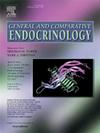Characterization of a direct role of GnRHs in the control of spermiogenesis and steroidogenesis in the small-spotted catshark Scyliorhinus canicula
IF 1.7
3区 医学
Q3 ENDOCRINOLOGY & METABOLISM
引用次数: 0
Abstract
Hypothalamic gonadotropin-releasing hormone (GnRH) regulates the production of gonadotropins, which control reproduction. In elasmobranchs, unlike other gnathostomes, GnRH is released into the systemic circulation to stimulate gonadotrope cells located in the ventral lobe of the pituitary. The aim of this study was to investigate the potential role of systemic GnRH in the regulation of the testis in Scyliorhinus canicula. Phylogeny and synteny analyses identified three GnRHs and four GnRH receptor (ScGnRHR-I1, -IIa1, -IIa2 and -IIb2). In vitro functional hormone-receptor interactions using synthetic ScGnRHs showed that all ScGnRHs were effective at receptors, except ScGnRHRIIa2, at femtomolar to nanomolar concentrations, with lower efficiency for ScGnRH1/ScGnRHRIIb2. Real-time PCR analyses in a wide range of tissues, including male and female reproductive tracts, showed that all three gnrh were expressed mainly in the brain and all four gnrhr were expressed in the testis, particularly during spermiogenesis. Testicular explants containing cysts with spermatids were treated with ScGnRHs and their protein content analyzed by NanoLC-ESI-MS/MS, highlighting 1677 significantly differentially expressed proteins. Among them, the growth hormone receptor (GHR) and proteins involved in cholesterol and steroid metabolism, including several HSD17bs, were upregulated. In situ hybridization showed that ghr, hsd17b3 and hsd17b12 transcripts were localized in Sertoli cells, which are the main testicular steroidogenic cells in S. canicula. Fifteen steroids were assayed in the culture media, using LC-ESI-HRMS/MS, and an increase in 17β-estradiol concentrations was observed, consistent with hsd17b expressions. Furthermore, proteins involved in transcription and DNA structure were downregulated in response to GnRHs. In conclusion, this study showed that ScGnRHs may play a direct role in the regulation of elasmobranch testes by promoting spermiogenesis and modulating steroidogenesis.

GnRHs在小斑点猫鲨(scylliorhinus canicula)精子发生和甾体发生控制中的直接作用
下丘脑促性腺激素释放激素(GnRH)调节促性腺激素的产生,促性腺激素控制生殖。在elasmobranches中,与其他颌口动物不同,GnRH被释放到体循环中以刺激位于垂体腹叶的促性腺细胞。本研究的目的是探讨全身性GnRH在管状鞘猴睾丸调节中的潜在作用。系统发育和同源性分析鉴定出3个GnRH和4个GnRH受体(ScGnRHR-I1、- ia1、- ia2和-IIb2)。体外使用合成的ScGnRHs进行功能性激素-受体相互作用,结果表明,除ScGnRHRIIa2外,所有ScGnRHs在飞摩尔至纳摩尔浓度下对受体有效,而ScGnRH1/ScGnRHRIIb2的效率较低。在包括男性和女性生殖道在内的广泛组织中进行的实时PCR分析显示,所有三种gnrhr主要在大脑中表达,所有四种gnrhr都在睾丸中表达,特别是在精子发生期间。用ScGnRHs处理含精细胞包囊的睾丸外植体,用NanoLC-ESI-MS/MS分析ScGnRHs蛋白含量,发现1677个表达差异显著的蛋白。其中,生长激素受体(GHR)和参与胆固醇和类固醇代谢的蛋白,包括几种HSD17bs上调。原位杂交结果表明,ghr、hsd17b3和hsd17b12转录本定位于Sertoli细胞中,Sertoli细胞是canicula主要的睾丸甾体生成细胞。使用LC-ESI-HRMS/MS对培养基中的15种类固醇进行检测,观察到17β-雌二醇浓度升高,与hsd17b表达一致。此外,参与转录和DNA结构的蛋白质在GnRHs的作用下下调。综上所述,本研究表明ScGnRHs可能通过促进精子发生和调节甾体生成来直接调节无骨支睾丸。
本文章由计算机程序翻译,如有差异,请以英文原文为准。
求助全文
约1分钟内获得全文
求助全文
来源期刊

General and comparative endocrinology
医学-内分泌学与代谢
CiteScore
5.60
自引率
7.40%
发文量
120
审稿时长
2 months
期刊介绍:
General and Comparative Endocrinology publishes articles concerned with the many complexities of vertebrate and invertebrate endocrine systems at the sub-molecular, molecular, cellular and organismal levels of analysis.
 求助内容:
求助内容: 应助结果提醒方式:
应助结果提醒方式:


